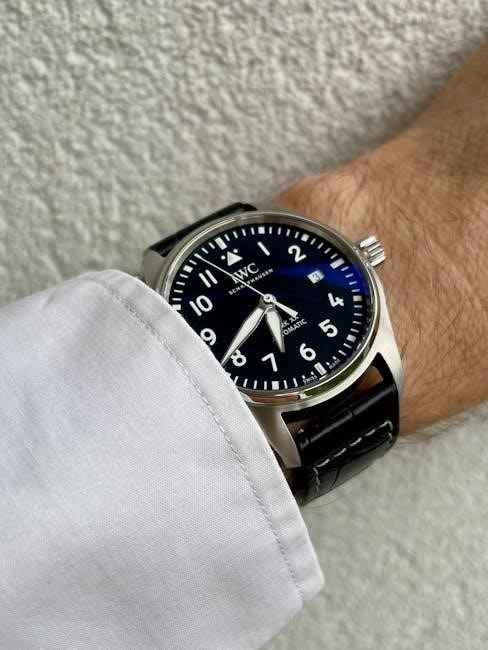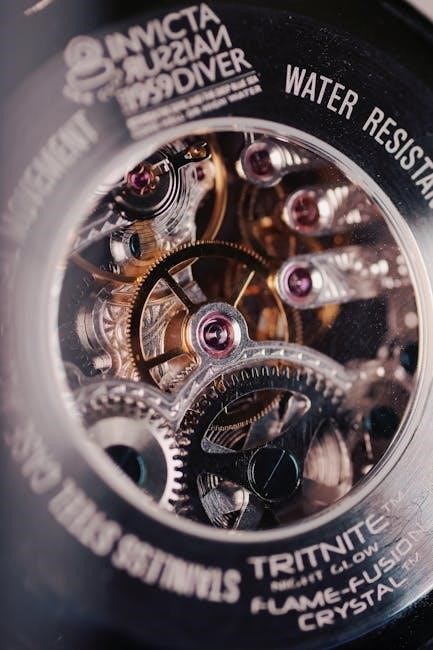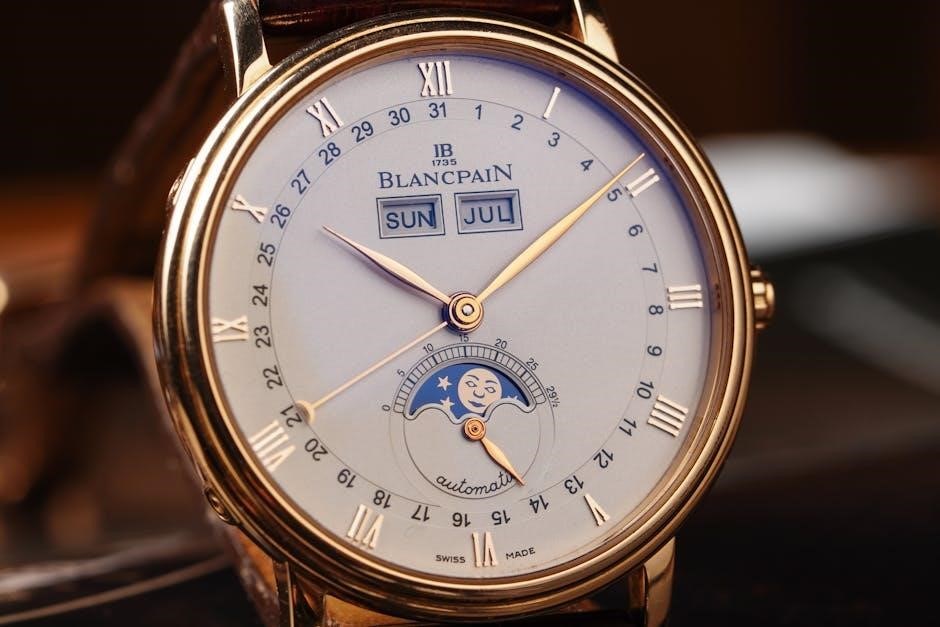Automatic and manual watches differ in winding mechanisms, with automatic watches using wrist motion and manual watches requiring daily winding. This article explores their mechanisms, advantages, and considerations for choosing the right timepiece.
Brief Overview of Automatic and Manual Watches
Automatic and manual watches are two distinct types of mechanical timepieces, each with unique winding mechanisms. Automatic watches, also known as self-winding watches, harness the wearer’s wrist movements to power the mainspring, eliminating the need for manual winding. This makes them convenient for everyday use. Manual watches, on the other hand, require the user to wind the mainspring daily by turning the crown, offering a tactile connection to the watch’s mechanics; Both types are popular among watch enthusiasts for their craftsmanship and horological significance. Automatic watches are praised for their convenience, while manual watches are cherished for their traditional appeal. Understanding their differences is essential for making an informed decision when choosing a timepiece.
Importance of Choosing the Right Watch Type
Selecting the appropriate watch type is crucial, as it directly impacts the user experience, maintenance requirements, and overall satisfaction. Automatic watches are ideal for individuals with active lifestyles, as they eliminate the need for daily winding, providing convenience and reliability. Manual watches, however, cater to those who appreciate traditional craftsmanship and the tactile pleasure of winding their timepiece. The choice also depends on personal preferences, such as design, size, and weight. Additionally, considerations like budget, maintenance costs, and resale value play significant roles. Understanding one’s lifestyle and watch usage patterns ensures a more informed decision. By aligning the watch type with individual needs and preferences, users can fully appreciate the craftsmanship and functionality of their timepiece, making it a meaningful and lasting investment.
Purpose of the Article
This article aims to provide a comprehensive comparison between automatic and manual watches, addressing their mechanisms, advantages, and considerations. It seeks to guide watch enthusiasts in making informed decisions by exploring key differences in accuracy, power reserve, maintenance, and aesthetics. By examining lifestyle factors, budget implications, and personal preferences, the article offers insights to help readers choose the most suitable timepiece. Whether one values the convenience of automatic watches or the craftsmanship of manual ones, this guide ensures a deeper understanding of both options, enabling readers to appreciate the intricacies of each movement type and make a choice that aligns with their needs and tastes. The goal is to empower readers with knowledge, ensuring their selection is both practical and meaningful.

Understanding Automatic Watches
Automatic watches, also known as self-winding watches, harness kinetic energy from the wearer’s wrist movement to power their mechanism, eliminating the need for manual winding, making them convenient and self-sufficient.
Definition and Mechanism of Automatic Watches
An automatic watch, also known as a self-winding watch, is a timepiece that uses the wearer’s movements to generate power. The mechanism relies on a weighted rotor that oscillates with every movement of the wrist. This motion winds the mainspring, which stores energy to power the watch. Unlike manual watches, automatic watches do not require daily winding, making them more convenient for everyday use. The rotor’s movement is transferred through a series of gears to the mainspring, ensuring a steady power supply. This innovative mechanism eliminates the need for manual intervention, providing a practical solution for watch enthusiasts who prefer low-maintenance timepieces. The seamless integration of functionality and design makes automatic watches both efficient and appealing to a wide range of users.
Key Components of Automatic Watches

Automatic watches consist of several essential components that ensure their functionality. The mainspring is the power source, storing energy as it winds. The gear train transmits this energy to the escapement, which regulates the release of power, ensuring precise timekeeping. The rotor, a weighted component, oscillates with the wearer’s wrist movements, winding the mainspring automatically. The balance wheel and hairspring work together to maintain accuracy, oscillating at a consistent rate. The dial and hands display the time, while the case and crystal protect the internal mechanisms. These components harmonize to create a self-sustaining timepiece that combines elegance with engineering excellence, offering both convenience and sophistication to the wearer.
How Automatic Watches Are Wound
Automatic watches are wound through the natural motion of the wearer’s wrist. A weighted rotor, typically made of metal, oscillates back and forth as the wrist moves. This movement is harnessed to wind the mainspring, which stores energy to power the watch. The rotor is connected to the gear train, which transmits the energy to the mainspring. The winding process is continuous, ensuring the watch remains powered as long as it is worn regularly. The efficiency of the rotor’s movement determines how quickly the mainspring is wound. While automatic watches are designed to function with everyday wear, they may require manual winding if not worn for an extended period. This self-winding mechanism eliminates the need for daily manual winding, making automatic watches a convenient choice for many users.
Advantages of Automatic Watches
Automatic watches offer several advantages, making them a popular choice among watch enthusiasts. One of the most significant benefits is the convenience they provide, as they eliminate the need for daily manual winding. This makes them ideal for individuals who wear their watches regularly. Additionally, automatic watches are equipped with a self-winding mechanism that ensures a consistent power reserve, typically ranging from 40 to 80 hours, depending on the movement. This means the watch can run accurately even when not worn for a few days. Furthermore, automatic watches often feature intricate mechanical engineering and craftsmanship, making them highly desirable for collectors. They also tend to hold their value well, especially high-quality models from reputable brands. Lastly, automatic watches are generally more durable and require less frequent maintenance compared to manual watches, making them a practical choice for everyday wear.
Disadvantages of Automatic Watches
While automatic watches offer many benefits, they also have some drawbacks. One notable disadvantage is their higher cost compared to manual watches, especially for high-quality models. Additionally, automatic watches can be heavier and thicker due to the rotor mechanism, which may not appeal to those who prefer slim, lightweight timepieces. They also require more maintenance than manual watches, as the complex movement can be prone to wear and tear over time. Furthermore, automatic watches can be noisier due to the rotor’s movement, which might be noticeable in quiet environments. If not worn regularly, automatic watches may stop running, requiring manual winding or shaking to restart. Lastly, while they are convenient, the reliance on wrist motion means they may not be the best choice for those with inactive lifestyles. Despite these drawbacks, many enthusiasts find the unique characteristics of automatic watches to be worthwhile.

Understanding Manual Watches
Manual watches require daily winding, offering a tactile experience and lighter weight. They lack a rotor, making them slimmer and appealing to purists. This trade-off between convenience and tradition attracts enthusiasts seeking a unique timepiece connection.
Definition and Mechanism of Manual Watches
A manual watch, also known as a hand-wound watch, is a timepiece that requires the wearer to wind it daily by turning the crown. This action tightens the mainspring, which stores energy to power the watch’s movement. Unlike automatic watches, manual watches do not rely on wrist motion to wind the spring. Instead, they depend entirely on the user to manually input energy. The process involves rotating the crown, typically 20-30 turns, until the mainspring is fully wound. Once wound, the watch will operate until the stored energy is depleted, usually within 24-72 hours, depending on the movement. Manual watches are often lighter and slimmer due to the absence of the rotor used in automatic watches. This design simplicity appeals to purists who appreciate the tactile experience of winding their watch and the direct connection to its mechanical heartbeat.
Key Components of Manual Watches
A manual watch consists of several critical components that work together to keep precise time. The mainspring is the power source, storing energy when wound. The gear train transmits this energy to the escapement, which regulates the release of power in measured intervals. The balance wheel oscillates, dividing time into equal parts for accuracy. The crown is used to wind the mainspring and set the time. The dial and hands display the time, while jewel bearings reduce friction in the movement. The case houses and protects the internal mechanisms. Unlike automatic watches, manual watches lack a rotor, resulting in a slimmer design. Additional features may include a power reserve indicator or complications like a date display. These components harmonize to create a timepiece that requires deliberate interaction, appealing to those who appreciate traditional craftsmanship and mechanical simplicity.
How Manual Watches Are Wound
Manual watches are wound by turning the crown, typically located on the right side of the case. This process involves rotating the crown clockwise to tighten the mainspring, which stores energy to power the watch. The winding mechanism transfers energy from the crown to the gear train and mainspring. Most manual watches require daily winding, as they lack the self-winding rotor found in automatic watches. The recommended winding frequency is usually once a day, preferably in the morning, to ensure consistent power delivery. Over-winding should be avoided, as it can damage the mainspring. The process is straightforward but requires deliberate effort, making it a ritual appreciated by enthusiasts of mechanical timepieces. Proper winding ensures accurate timekeeping and maintains the watch’s functionality. Regular winding also helps prevent the watch from stopping due to a depleted power reserve, ensuring it remains precise and reliable.
Advantages of Manual Watches
Manual watches offer several unique advantages that appeal to enthusiasts. They are often lighter and slimmer compared to automatic watches, making them more comfortable for everyday wear. The absence of a rotor allows for a more compact design, which can be aesthetically pleasing. Additionally, manual watches typically have a lower power reserve, which means they require daily winding, fostering a connection between the wearer and the timepiece. This ritual can be meditative and satisfying for those who appreciate the craftsmanship behind mechanical watches. Furthermore, manual watches often have simpler movements, which can make them easier to service and repair. They also tend to be more affordable than automatic watches, offering an accessible entry point for collectors. Overall, manual watches provide a blend of elegance, simplicity, and tradition that continues to attract watch enthusiasts worldwide.
Disadvantages of Manual Watches
Manual watches have several drawbacks that may deter some users. The most notable inconvenience is the need for daily winding, which can be easily forgotten, leading to the watch stopping. This dependency on manual intervention requires discipline and can be impractical for those with busy lifestyles. Additionally, manual watches are more prone to accuracy issues if not wound consistently or properly. They also tend to have a shorter power reserve, typically lasting between 36 to 48 hours, which means they must be wound frequently. Furthermore, manual watches often lack the aesthetic appeal of automatic watches, as they do not have a rotor visible through the caseback. While they may be more affordable initially, their long-term maintenance costs can add up. Finally, improper winding techniques can potentially damage the movement, making manual watches less forgiving for inexperienced users. These factors make manual watches less convenient for everyday use compared to automatic watches.

Comparing Key Features
Automatic and manual watches differ in winding mechanisms, accuracy, power reserve, maintenance, size, weight, and design, offering distinct advantages based on lifestyle, budget, and personal preference.
Accuracy: Automatic vs. Manual Watches
Accuracy is a critical factor when comparing automatic and manual watches. Manual watches are generally more accurate because they are wound by hand, allowing for precise control over the mainspring. This direct winding method minimizes variations in power delivery, resulting in consistent timekeeping. Automatic watches, while convenient, rely on the wearer’s movement to wind the mainspring, which can lead to slight inaccuracies due to inconsistent energy supply. However, high-quality automatic watches often feature advanced mechanisms to regulate this variability. Over time, both types can drift slightly, but manual watches tend to maintain better accuracy if wound regularly. Regular maintenance, such as servicing, is essential for both types to ensure optimal performance. Ultimately, the choice between the two depends on the wearer’s lifestyle and the level of precision they require from their timepiece.
Power Reserve: Automatic vs. Manual Watches
Power reserve is a key feature that distinguishes automatic and manual watches. Automatic watches typically have a longer power reserve, often ranging from 40 to 80 hours, depending on the movement. This is because they continuously wind themselves through the wearer’s wrist movements, storing excess energy in the mainspring. Manual watches, on the other hand, require daily winding and usually have a shorter power reserve, typically between 40 to 60 hours. However, manual watches can sometimes offer more consistent power delivery since the energy stored is controlled by the user. Automatic watches are more convenient for everyday wear, as they do not require manual intervention, while manual watches appeal to enthusiasts who appreciate the ritual of winding. Both types benefit from regular maintenance to optimize their power reserve performance. The choice ultimately depends on the wearer’s lifestyle and preference for convenience versus tradition.
Maintenance Requirements: Automatic vs. Manual Watches
Maintenance requirements differ significantly between automatic and manual watches. Automatic watches generally require more frequent servicing due to their complex mechanisms, including the rotor and gear systems. These components are prone to wear and tear over time, necessitating professional maintenance every 5 to 10 years to ensure optimal performance. Manual watches, while simpler in design, still need regular servicing to maintain accuracy and functionality. However, their fewer moving parts mean they often require less frequent servicing compared to automatic watches. Both types benefit from periodic cleaning and lubrication to prevent mechanical degradation. Additionally, proper storage and handling can extend the lifespan of either watch type. Regular maintenance is essential to preserve the precision and longevity of the timepiece, regardless of whether it is automatic or manual. Enthusiasts often recommend sticking to a consistent maintenance schedule to uphold the watch’s performance and aesthetic appeal.
Size and Weight Differences
Automatic and manual watches often differ in size and weight due to their internal mechanisms. Automatic watches tend to be slightly thicker and heavier because of the rotor mechanism, which is necessary for self-winding. This added component can make automatic watches feel more substantial on the wrist. In contrast, manual watches are typically slimmer and lighter, as they lack the rotor and rely solely on the mainspring. However, the size difference can vary depending on the specific design and brand. Luxury brands sometimes create slim automatic watches to cater to those who prefer a more elegant look. Ultimately, the choice between the two may come down to personal comfort and aesthetic preferences. While automatic watches offer the convenience of self-winding, manual watches provide a lighter and more minimalist option for watch enthusiasts.
Aesthetic Appeal and Design
The aesthetic appeal of automatic and manual watches varies, catering to different tastes and preferences. Automatic watches often feature a more robust design, with visible rotors that add a touch of sophistication. Many luxury brands emphasize the intricate mechanics of automatic movements, sometimes showcasing them through transparent case backs. Manual watches, on the other hand, tend to have a cleaner, more minimalist aesthetic, appealing to purists who appreciate simplicity and classic design. The absence of a rotor allows for slimmer profiles, making manual watches a favorite among those who prefer understated elegance. Additionally, the design of manual watches often highlights the craftsmanship of traditional watchmaking, with subtle details that resonate with enthusiasts. Ultimately, the choice between the two comes down to personal style and the desired visual impact on the wrist.

Considerations for Watch Enthusiasts
Watch enthusiasts should weigh lifestyle, budget, and personal preferences when choosing between automatic and manual watches. Factors like usage frequency, resale value, and emotional connection also play a significant role in decision-making.
Lifestyle and Watch Usage
Lifestyle plays a crucial role in choosing between automatic and manual watches. Active individuals who wear their watches daily may prefer automatic watches for their convenience, as they eliminate the need for manual winding. Conversely, those who appreciate the ritual of winding their watch or have a more sedentary lifestyle might lean toward manual watches. Travelers or individuals with multiple timepieces may favor automatic watches due to their self-winding capability, ensuring the watch remains accurate even when not worn. Meanwhile, manual watches appeal to collectors who value tradition and the tactile experience of winding. Ultimately, the decision should align with how often the watch will be worn and the user’s personal connection to its functionality. Balancing practicality with personal preference ensures the best fit for one’s lifestyle and watch usage habits.
Budget and Cost Implications
The choice between automatic and manual watches can significantly impact your budget. Automatic watches are generally more accessible at entry-level price points, making them a popular choice for many. Manual watches, while also available in various price ranges, tend to be more expensive, especially for high-quality, intricate models from reputable brands. The cost implications extend beyond the initial purchase, as maintenance and servicing requirements differ. Automatic watches, with their complex mechanisms, often incur higher servicing costs over time. Manual watches, though simpler in design, can still be costly to maintain, particularly if they are luxury pieces. Additionally, resale value varies, with manual watches from esteemed brands often retaining value better than automatic counterparts. Ultimately, your budget and long-term financial commitments should guide your decision, ensuring the watch aligns with both your resources and aspirations.
Resale Value and Collectibility
Resale value and collectibility are crucial factors for watch enthusiasts. Generally, manual watches tend to hold their value better than automatic watches, particularly if they are from prestigious brands like Patek Philippe or Rolex. These timepieces are often sought after by collectors due to their intricate craftsmanship and historical significance. Automatic watches, while still collectible, may not retain their value as consistently unless they feature unique complications or are part of limited editions. The exclusivity and rarity of manual watches contribute to their higher demand in the secondary market. Additionally, manual watches are often associated with a more traditional and artisanal appeal, making them desirable for connoisseurs. However, both types can appreciate over time if well-maintained and from reputable manufacturers. Ultimately, resale value and collectibility depend on factors like brand, model, condition, and market demand.
Personal Preference and Emotional Connection
Personal preference and emotional connection play a significant role in choosing between automatic and manual watches. Some individuals prefer the convenience and practicality of automatic watches, appreciating how they eliminate the need for daily winding. Others find joy in the tactile experience of manually winding a watch, which can create a sense of ritual and connection to the timepiece. Emotional factors often tie into the watch’s design, brand heritage, and craftsmanship. For instance, manual watches are often praised for their traditional appeal and mechanical artistry, resonating with purists who value horological history. Conversely, automatic watches may appeal to those who appreciate modern engineering and innovation. Lifestyle and personal taste ultimately dictate which type resonates more deeply, making the choice as much about passion as it is about functionality.
Choosing between automatic and manual watches depends on lifestyle, preferences, and needs. Both offer unique benefits, making the decision a balance of convenience, craftsmanship, and personal connection to horological traditions.
Final Thoughts on Choosing Between Automatic and Manual Watches
Choosing between automatic and manual watches ultimately depends on personal lifestyle and preferences. Automatic watches offer convenience and self-winding functionality, ideal for everyday wear, while manual watches provide a tactile experience and a deeper connection to horology. Consider factors like maintenance requirements and accuracy to make an informed decision.
